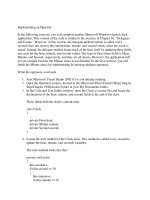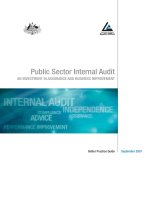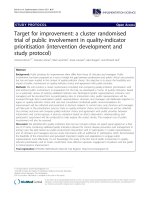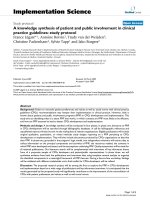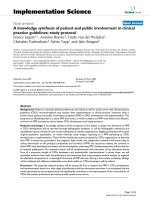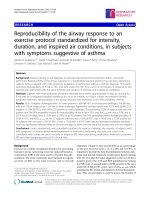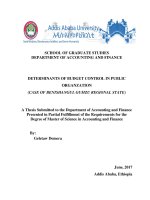Budget Advice Scorecard An Exercise in Public Involvement & Prioritization
Bạn đang xem bản rút gọn của tài liệu. Xem và tải ngay bản đầy đủ của tài liệu tại đây (174.56 KB, 7 trang )
Budget Advice Scorecard: An Exercise in Public Involvement & Prioritization
City of Janesville, Wisconsin
Eric Levitt, City Manager
Primary contact: Jacob J. Winzenz, Director of Administrative Services/Assistant City Manager,
608-755-3067,
Presenting team members:
Eric Levitt, 608-755-3177,
Jacob J. Winzenz
Gordon LaChance, IT Manager, 608-755-3204,
Rebecca Smith, Management Assistant, 608-755-3104,
SYNOPSIS
Janesville is Wisconsin’s tenth largest city with over 60,000 residents and a long history of the
council-manager form of government. Janesville provides high-quality amenities to residents
and we pride ourselves on our low taxes and customer satisfaction. We are located in southcentral Wisconsin along Interstate-90 and the Rock River and are best known for our beautiful
park system and friendly people. Our economic roots are in manufacturing; however, the health
care industry is an emerging growth area and agriculturally-based businesses continue to be a
strong contributor to the economy. Janesville is a working-class, fiscally conservative, pro-union
community.
Background
In the late 1990s and the early 2000s, Janesville experienced positive growth and enjoyed
economic success. Unemployment was low and citizens were open to expanding services and
facilities to make Janesville more attractive. Janesville expanded its bike trail system, built parks,
opened new city facilities, renovated buildings and enjoyed the benefits of prosperity. While
maintaining prudent fiscal reserves, Janesville City Councils were willing to make expenditures
to better the community’s quality of life.
Similar to municipalities and states nationwide, in recent years, Janesville has been negatively
affected by changes in the economy. Our largest employer, General Motors, closed its
manufacturing plant in December 2008 and over 2,000 jobs were lost. We’ve felt the decline of
the housing market, with an increase in foreclosures, decreases in housing starts and small
businesses closing under fiscal pressure. Janesville has also become more sensitive to economic
decisions – residents are quicker to judge service level and budgetary decisions; budget cuts,
wage freezes, furloughs and layoffs are commonly mentioned solutions by residents to the City’s
financial problems.
As fiscal constraints grew, the City’s expert financial team was always able to find a solution or
mend together a “quick fix” to the City’s budget without much “pain” for any one department or
any major cuts visible to the public. To date, the City has only laid off two individuals in over ten
years and we have not experienced furloughs.
The Administration felt that there is a disconnect between our residents’ desire for continued or
increased services and their willingness to pay for them. As Assistant City Manager Jacob
Winzenz has shared, if a citizen wants a restaurant meal with a complex menu and very attentive
service, they expect to pay a higher price for their meal. Whereas, residents continually expect a
very high level of service from their local government, but don’t believe that cost increases must
occur to maintain city service levels. While the City has “cut the fat” from departments to meet
budget goals, the days of reducing budgets, but keeping service levels the same are over. In
addition to our attempt to connect the services and the cost of the services, the management team
believes that community input up front in the budget process is a necessary additional tool as we
head into potentially our most difficult budget times. Instead of receiving reactions to tax
increases or budget reductions at the end of the budget development process, we are attempting
to receive quality community feedback on citizen’s preferences of service reductions or tax
increases during the budget development timeframe.
2
What is the Budget Advice Scorecard?
With Janesville’s current fiscal concerns, the Administration desired a way to examine the
services we offer and get feedback in a new way from residents. The City offered an online
survey (www.ci.janesville.wi.us/scorecard1) for residents to look at the shopping cart of core
services they purchase through their tax dollars and provide input on what Levels of Service
should be provided in 12 core areas, including fire/EMS services, police, parks, recreation,
transportation, trash collection, and snowplowing. Before residents completed the survey, a
YouTube presentation was available for them to watch if they desired. For each core service,
there were four service level options and respondents were asked to choose the service level they
believe the department should provide. The questions were tough and made residents think about
what each service was “worth” to them. The survey was available for ten days in July and there
were computers at the library, senior center and the Municipal Building for those that didn’t have
internet access at home. The results of the survey were available to department heads as work
began on the 2011 budget. This allowed us to be proactive, so that we do not have to respond
with knee-jerk decisions later.
The initial idea for this scorecard project came from Mr. Winzenz’s trip to the LEAD program at
the University of Virginia a few years ago. They reviewed similar projects from Sarasota County,
FL and Round Rock, TX. When Janesville decided to use this idea, IT staff adjusted the survey to
put our spin on it. Respondents input their home’s assessed value and as they made service level
choices, their approximate increase or decrease in the property tax bill was calculated. We also
used graphics to depict how our city property taxes were used and polled respondents on how
they wished to pay for their services (property tax revenue, user fees or a combination).
Purpose of Budget Advice Scorecard
The Administration sees several purposes for this project:
Illustrate to the public the correlation between service level and cost;
Engage residents in the service level discussion early so that rash budgetary decisions
won’t be made later;
Determine general preferences regarding service options and preferences on how to pay
for services;
Provide another tool to the Janesville City Council as they make budget decisions; and
Encourage city staff to participate in budgeting by offering their ideas regarding service
level changes.
Anticipated & actual outcomes
We anticipated a few outcomes for this project:
We thought we would receive positive press for our efforts;
We expected staff to be hesitant or nervous to put their services “on the line”;
We hoped for 2,500 completed surveys;
We wanted to begin a process of educating the community on the costs of municipal
services and establish a connection between the property taxes they pay and the “market
basket” of services they receive from the City; and
We desired to further involve all staff in the budget process.
3
We were correct with regards to media coverage; the newspaper featured a guest article from the
city manager in the opinion section and we had a positive editorial a few days later. We took
advantage of a few TV interview offers and the manager spoke on the local radio station. The
overall tone of the media coverage was positive and we were praised for our openness and
initiative. We were also correct that some staff felt nervous or territorial about the services they
provide and questioned why we would leave our city budget decisions to an online survey. The
Administration iterated that this survey is simply one more tool for the Council and not a
referendum on their budget or a popularity contest.
We received 775 completed surveys, short of our goal of 2,500, but more than what Round Rock
received with a population of almost twice ours. Many of the citizens that completed the survey
shared comments explaining that they felt the choices were tough or that they had to go back and
change their answers based on the tax bill calculations. These kinds of comments were exactly
what we were looking for and demonstrated to us that these respondents were connecting the
costs of various services levels to the property taxes they pay. Several citizens praised us for
offering this interactive, innovative public input opportunity and shared they have a better
understanding of city costs after watching the presentation and completing the survey. Of course,
we also had negative comments about the quality of the survey or the options given.
Staff’s reaction to the survey is mixed. During our employee meetings to share information about
the project, some employees fully engaged in the process and asked thoughtful questions. Others
were fearful about possible outcomes, but most were neutral or seemed underwhelmed. With
over 450 employees in the organization and 775 completed surveys, it appears that many
employees did not take the opportunity to participate, even with encouragement to do so by the
Administration.
Costs and/or Savings
There were little monetary costs, but very significant staff time was used to implement this
project. Our estimate of staff time to technically program, publicize, implement and organize the
project is around 350 staff hours. Staff for each of the 12 core services areas also spent time
determining their options which totaled approximately 120 more hours. Funds were used for
some minor printing and the City also paid a translator to write the survey in Spanish.
Identify innovative characteristics
We see the following innovative characteristics as pertinent to this project:
Technology – use of an online survey; this was our first foray into using YouTube to host
our presentation videos
Interactiveness and Immediate Feedback – respondents were able to immediately see the
impact of their service level choices on their property tax bill. In this way they could
adjust their service level preferences based upon their willingness to increase or decrease
their property tax bill.
Intergovernmental cooperation – we hosted two public meetings about the project at two
schools and attendees were able to use the school’s computer system to complete the
survey on site. The city IT technician that handled this mentioned that it was nice to meet
his counterparts in the school district for the first time through this project.
4
Positive media relations – we met with local media representatives prior to announcing
this project to give them a tour of the survey and to answer their questions. It was nice to
meet with them for an in-depth conversation more than the typical once a year meeting
related to the annual budget.
Obstacles
Staff sees that there were two obstacles to the successful implementation of this program, time
available and resident participation. The timeline to complete this project was very short; the IT
Division and the City Manager’s Office “lived and breathed” this project for about three weeks
straight. While we would have liked more time, we were able to accomplish our goal of opening
the survey to the public on time and much of the background for the project is completed if we
would wish to do it again. Lack of time also impacted the way the survey was presented online.
There are a couple entry boxes on the form that we would have preferred to present differently,
but we didn’t have the time to implement them.
The second obstacle to success was resident participation. To consider the survey beneficial and
worthwhile to the budget process, we needed as many completed surveys as possible. The survey
went live after the July 4th holiday weekend in a prime vacation time period, which may have
contributed to a low number of surveys submitted. While we fell short of our goal, we feel that
we have laid positive groundwork for the future use of this survey.
Any new issues/problems (unintended consequences or things you didn’t expect) you
encountered as a result of your program
While we have not implemented changes yet, there have been few unintended consequences so
far. Some of the feedback we received indicated the public did not like the options presented –
they wanted to keep portions of one option and bundle it with parts of another option. The
possibilities for choices would be endless and would not lend itself to a viable way of extracting
trends in the data
We also found that by listing some service level changes, we destined ourselves to implementing
that choice. For example, our building maintenance core service showed a proposed cut as
eliminating trash service from individual employee desks; instead, staff would bring trash to
designated areas. This option was one that was called out frequently in the comments section as
something that should be done; therefore, staff will likely have to implement this option with the
2011 budget.
Lastly, we did not establish any parameters for the dollar value of service level increases or
decreases. The budget impact for a service level enhancement to one core service may have been
$10,000 while the budget impact for the enhancement to another core service may have been
$500,000. This will tend to skew the results because respondent are much more likely to choose
the enhancement with the minor budget impact rather than the one with the more significant
impact. This can make it appear that one core service is a higher priority than another when that
may not be the case. The answer always depends upon how you ask the question.
5
PRESENTATION COMPONENTS
Innovation/Creativity
How did the program/project/service, etc. improve the organization?
This program improved the organization in three ways. First, this exercise gave the public
another way to provide feedback to the Administration. This will help us align our spending and
services with the desires of the public. Next, this survey gave the Administration a jump-start on
the budget process to ensure that we do not have to make rash decisions later. Finally, this survey
began the process of educating the public on the costs of the services they receive from the City.
Were new technologies used? If yes, what methods and/or applications did you implement?
New technologies for our organization were used and previously used technologies were used in
a new way. First, this project was our first foray into using online video presentations; we used
YouTube for the information presentation that was linked on the survey webpage with positive
results. Next, we used our IT Division’s capabilities with online forms to create the survey. This
was the most complex online form they have drafted and the results were very positive. The form
was very professional and compliments were received.
Was a private consultant used?
No.
Outcomes Achieved
What customer/community needs and expectations were identified and fulfilled?
First, residents could personally experience budget decision-making by choosing a service level
option and noting the calculated tax bill change. Second, this survey demonstrated our
commitment to public involvement and transparency, which further lends credit to our
organization.
Has service delivery been enhanced?
At the time of writing this application, we have not changed our service levels; however, as part
of the 2011 budget process staff will implement service level changes (likely reductions) based
on the feedback received from the survey. We are also more prepared to take on future survey
application forms based on our technical experiences with this project.
Did the initiative improve access to your government? If yes, how?
Yes, the Scorecard project improved access to our government. Citizens were able to meet with
staff if they needed help with the survey at various city buildings. The Administration also held
two public meetings to share information about the project. While they were very lightly
attended, those residents that came felt very satisfied with their ability to share comments oneon-one with staff. The survey also allowed residents the ability to peek into the issues and
experience the tough choices that the Council faces each year when they adopt the budget.
Has the health of the community improved as a result? If yes, how?
Yes, the Scorecard project improved the health of the community because this effort is helping us
align the services we provide residents with the options they desire. Citizens do not have the
ability to shop elsewhere for the services provided to them through their local government, so it
6
is important for the Administration to take into consideration feedback from residents when
determining service levels.
Applicable Results and Real World Practicality
What practical applications could you share if selected?
We could share our experiences related to the following items:
Technical experience with setting up the database survey
Public information efforts – what worked and what did not
Experience sharing this concept with our City Council and their reaction to its
implementation
Experience in implementing the results of the survey in our budget development process
How applicable is the project/program/service to other local governments?
Staff thinks this survey could be helpful to any local government that is experiencing fiscal
difficulties where services may need to be reduced or eliminated. The framework would also be
beneficial to municipalities who want to make sure the services they are providing are the ones
that are desired by their population.
What results/outcomes will you be able to share?
We would be able to share the results of the survey and how those results were used in our
budget development process. We would also be able to share our experience in implementing this
service with regards to technology and public information.
Please include any performance measures if applicable
Not applicable.
Case Study Presentation
Briefly describe what your case study presentation might include.
We would use a PowerPoint presentation to describe the general concept of the program, with a
live demonstration of what the citizen would do to complete the survey. Small groups of
attendees could complete the survey as a citizen would if computers are available. We are also
open to your ideas on ways to make the presentation interesting.
7
